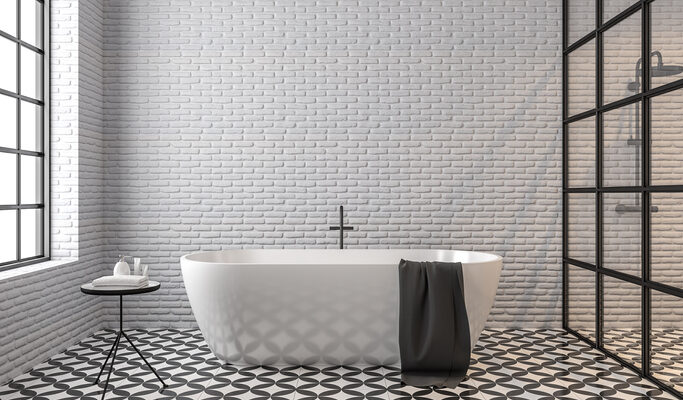Tile layout patterns can be a great way to incorporate style and sophistication into your home. There are many different styles and variations of these patterns, so it can be difficult to choose the right one for your home. In addition to this, when looking up patterns it’s easy to be confused by all the different terms, such as Versailles and Herringbone. To make the process easier, here is an outline of some popular floor tile layout patterns and what they can bring to your home.
Square-set or Straight-set Tile Pattern
This is a common layout pattern, also known as the running board or subway tile pattern. Straight-set tile patterns are simply laid out in horizontal or vertical lines without any overlap. The square set pattern utilises square tiles of the same size laid out in straight lines to give the effect of a grid. Due to its simple layout, this pattern is usually added to rooms to not distract from other design elements. It is generally used as a backdrop for backsplashes and feature walls but can be adapted for floors as well.
Checkerboard Tile Pattern
This type of pattern is created by alternating light and dark tiles in both horizontal and vertical lines. The result is a simple but effective design that can be used in almost any room of the house. A checkerboard pattern will add a bit of visual diversity while being relatively neutral in terms of colour and texture.
Herringbone Pattern
As the name suggests, this pattern looks like fish bones when viewed from above – each tile is laid out at a 45-degree angle creating a zigzag effect. This tile layout pattern can appear more complex but gives a more modern feel. The herringbone pattern is a popular choice, ideal for achieving a classic look with a bit more texture.
Versailles Tile Pattern
Versailles is a classic and timeless choice when it comes to tile layout patterns. This pattern involves setting large square tiles with smaller rectangular ones arranged around them in an overlapping fashion similar to bricks on a wall. This type of layout pattern works well on important surfaces such as garden patios or living rooms because it creates an eye-catching focal point that stands out from other aspects of décor in the room. Perfect for creating an elegant atmosphere in any home.
Brick Style Pattern
This layout features rectangular pieces laid out like a brick wall. This is a great choice for achieving a more rustic look and feel, perfect if you are going for a cosy cottage vibe.
Diagonal Tile Pattern
This simple pattern features square tiles of the same size laid from corner to corner creating diamond shapes throughout the floor design. This pattern emphasises angels in a space and is typically used in bathrooms.
Tips on Tiling Your Home
Although it is best practice to call a professional it does cost extra for the labour. If you are planning on doing this yourself here are some tips to get started:
- Measure Twice and Cut Once: Before you start your project, take the time to accurately measure your space and double-check your measurements. This will ensure that you order the right amount of tile and cut the tile to the right size and shape.
- Prep the Surface: Before you lay the tile, make sure that the surface is clean and free of any debris. Make sure to fill any cracks or gaps in the surface with a suitable material.
- Choose the Right Mortar and Grout: Select the appropriate mortar and grout to ensure a strong bond and long-lasting installation.
- Plan the Layout: Take the time to plan the layout of your tile. This will make the installation easier and can help you achieve the desired look.
- Prep the Tile: Before you install the tile, make sure to inspect each piece and clean it off with a damp cloth.
- Lay the Tile: When laying the tile, make sure to use a trowel with the right size notches. This will ensure that the mortar is spread evenly and the tile is laid properly.
- Caulk the Seams: Once the tile is laid, make sure to caulk the seams to ensure a waterproof seal.
Conclusion
Choosing the right tile layout pattern is crucial for the design aesthetic of your home. Having this information beforehand saves time and reduces frustration during installation. No matter what kind of tile layout you are dealing with, planning ahead is key so you know precisely how much material you need for the project before you dive in. Tiling your own home can be a challenging but rewarding process. However, with proper preparation and research, you can achieve a professional-looking job. Now you are more educated on the most common tile layout patterns and how to install them, you can make a better-informed decision on your home tiling project.



